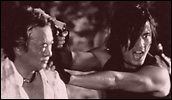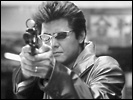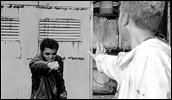Dead or Alive: Final
- Year
- 2002
- Original title
- Dead or Alive: Final
- Japanese title
- DEAD OR ALIVE FINAL
- Alternative title
- Dead or Alive 3
- Director
- Cast
- Running time
- 89 minutes
- Published
- 23 December 2002



by Nicholas Rucka
In 1999, Takashi Miike blew the top off the V-cinema yakuza archetype - and indeed the action film archetype - by overusing and twisting the model back on itself in the highly combustible Dead or Alive. The film is a methamphetamine-amped, punch-drunk epic that pits the 'good guy, bad guy' character-type (Sho Aikawa and Riki Takeuchi, respectively) against one another in the ultimate showdown. Only when the last of the dust settles from the delirious chaotic conclusion does the audience realize that they have seen a truly prophetic masterpiece. They say, as I said, "Well... now that that's been done, there's no place to go with this type of film."
Wrong.
Miike came back in 2000 with Dead or Alive 2, a stylistic reversal from its predecessor with a decrease in violence (comparatively) and a friendship/charity theme. Ostensibly continuing his use of the 'good guy, bad guy' character-types he and writer Ichiro Ryu (a pseudonm for producer Toshiki Kimura) created for the original Dead or Alive, this time around the characters switched from being personified ultimate genre types to being the meta-spirits from the first film as if they were reincarnated in different roles and positions, in other times and places. In a sense, Miike and his writers have roleplayed through a few set scenarios with the same characters (essentially, Dead or Alive 2 and Dead or Alive: Final are "What if..." pictures), the main difference being that the underlying meanings of the Aikawa and Takeuchi characters have been transposed for parts two and three.
Dead or Alive: Final is an exceptional and very energetic entry into this series and does a good job combining the genre twisting of part one with the roleplaying, character swapping of part two. The best way to describe it is as a science-fiction/action film amalgam of the first two entries with some added spice. Set in 2346 Yokohama, Japan, the film is another genre blowout that manages to also take the piss out of not only itself but two famous SF titans: Blade Runner (1982) and Tetsuo: The Iron Man (1989).
Boasting three (!) writers and shot on what appears to be High Definition Video, DOA: Final is a dystopian vision of futuristic Yokohama, where everyone speaks a blend of Cantonese, English, and Japanese and the sky is the color of a 15-year-old computer monitor: yellow and dirty, with a desaturated color palette.
The gay dictator Woo (Richard Cheung) rules Yokohama with an iron fist and is attempting to build a peculiar totalitarian society where procreation is verboten. To this end he forces the population to ingest pacifying birth control pills that will lead to his dream of zero population growth. Enforcing the law is the ruthless Honda (Takeuchi), a 'supercop' with black shades and a permanent sneer pasted on his face.
For every oppressive regime there is a group of rebels. This film's is lead by English-speaking Fon (Terence Yin) and his Cantonese-speaking lover Jun (Josie Ho). They are aided by spiky-haired, Japanese-speaking Ryo (Sho Aikawa), a 'Replicant' (cyborg), who has super-amplified reflexes and strength. This combined with Ryo's 'Matrix' style bionic vision that sees bullets tunneling through the air in transparent rip-curls, helps him to fight with unbelievable power and precision. Ryo ends up becoming at first a passive and then an active member in Fon and Jun's organization after helping save Jun's kid brother from Woo's jack-booted police force. Before you can get the story straight in your head, Honda and Ryo have their first showdown, which ends inconclusively.
The rebel group then tries to attack Woo directly but fails, suffering substantial casualties. Hitting on another plan, the rebels decide to kidnap Honda's son, Takeshi. The rebels succeed, but Honda, aided by the equally lethal Michelle (Maria Chen), manages to track down Takeshi - but not before Honda discovers that the world he operates in is far more complicated then he imagined and Woo has been playing him for the fool all along...
The scholar in me immediately wants to label these Dead or Alive films as postmodern action works. They have all of the qualities of being so, but it's totally inaccurate for me to label them as such; at least from a Western definition. In the case of Dead or Alive, it is the film's replacement of linear causality and stable meanings that seem to be a telltale sign of it being postmodern. But unlike our Western definition of postmodernism, while seeming to have consistencies to a similar movement in Japanese art, it developed in a totally different culture and manner out of a different set of predetermining factors than the Japanese arts. The Japanese work therefore is infused with a different intent and meaning. While Miike was no doubt influenced by some of the same so-called Western 'postmodern' art, books, music, and other items, I doubt that he consciously chose to approach Dead or Alive in this way.
Perhaps this is painfully obvious, but I believe that something far simpler occurred; and this is something that I want to put out on the table, so to speak. I think that Miike's take on the V-cinema yakuza flicks seems to have arrived as much out of his exhaustion with the genre as with a general boredom with a repeated standard approach to storytelling and character types. The films - and in particular the first one - is meant more as a 'Let's shake it up and fucking try it this way!' then as a purely artistic, intellectual exercise.
My first feelings coming out of Dead or Alive was that it was one of the most exciting movies that I had seen in recent memory. My second thought, which was far more revealing and inspiring for me, was that as a storyteller, all you have to do is believe in the logic of the story you're telling, and never ever wink and give in to the absurdity of it. The audience will believe in anything as long as you as a filmmaker show confidence and no signs of wavering.
Miike has done this with all of the Dead or Alive films. This time out, he has roleplayed the characters in an absurd sci-fi way that plays with Hong Kong and Japanese action, Japanese and Western science-fiction, video games, anime, and whatnot, as much as it is playing with the character and story themes from the previous two films. With Dead or Alive: Final, Miike has almost reached all of the way around, like an Ipecac loop, and is now mocking and mining his own movies. Basically, as soon as this film is done, you can go ahead and pop out this disc and just jam in part one again - ad infinitum. It works!
This is a smart decision on Miike's part. The first film was definitely a standalone piece. But when he did the second one, the game became much more complicated; he ignored the first one's story conclusion so he could play with the first film's characters in other absurd settings. By establishing a third and final film, the Dead or Alive franchise once again became about the storytelling, character types, and of course, the action film. The third film helped the series regain its stability.
I think you'll like this film just fine if it's the first one viewed in the series, but ultimately, this is a film for the Dead or Alive series fan. And what a film it is.